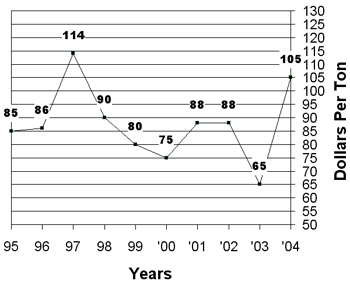Production Update:
Rhizoctonia: Rhizoctonia
solani is usually of minor importance in Arizona, but the fungus
can cause severe stand loss in some situations. Rhizoctonia is very versatile
and can cause decay of the roots, stem, and leaves as well as the crowns.
Symptoms usually occur during the warmer part of the growing season. Circular,
concave, black lesions can appear on taproots but are not always seen
in Arizona. Crown decay appears as dark, rotted areas within the crown
tissue. The fungus can also girdle the stem near the soil line. The disease
can cause circular lesions on the leaves. Control measures include resistant
varieties, proper land leveling, and avoiding over-irrigation. No effective
chemical control measures exist for rhizoctonia.
Insect Management: Alfalfa caterpillar, Colias eurytheme,
(
picture)
also known as alfalfa butterfly, is a warm weather pest of alfalfa (more
information Alfalfa
Caterpillar/Butterfly PDF file, 74 KB. There can be as many as seven
generations between May and October, in the low desert. Start checking
fields for alfalfa caterpillars when yellow alfalfa butterflies (
picture)
first appear in May. When alfalfa butterflies are seen flying over tall
alfalfa, they most likely emerged from that field. Eggs are laid singly
(
picture),
standing on end, on the upper surface of leaves in fields with re-growth
under 6 inches. Larvae hatch in 3 to 10 days, grow to about an inch long
and pupate in approximately two weeks. Alfalfa caterpillars are green
with white stripes down their sides and are distinguished from beet armyworm
by their velvety appearance. Monitor fields weekly from June through October,
checking 2 to 3 times per week during periods of heavy infestations. Take
5 sweep counts in 4 to 5 field locations. Check worms for parasitism by
pulling heads off an alfalfa caterpillar larva, squeeze out the body contents,
and looking for an Apanteles wasp larva. Treat when field counts
average 10 non-parasitized caterpillars per sweep.
Weed Control: Bermudagrass can be controlled with multiple
applications of Select/Prism or Poast. The highest labeled rates of theses
herbicides will slowly desiccate this weed over a 2 to 3 week period although
regrowth will often occur a couple of weeks later. Two or three applications
during the summer for two or three summers will bring this invasive perennial
under control.
| Market Summary |
High
|
Low
|
Average
|
Off grade
|
| Past 2 Weeks (2004) |
115
|
90
|
105
|
80-90
|
| Last Year (2003) |
70
|
60
|
65
|
50-60
|
10 Year Summary (June 2, to June 13, 1995-2004):

Issued in furtherance of Cooperative Extension work, acts of May 8 and June 30, 1914, in cooperation with the U.S. Department of Agriculture, James A. Christenson, Director Cooperative Extension, College of Agriculture and Life Sciences, The University of Arizona.
The University of Arizona is an equal opportunity, affirmative action institution. The University does not discriminate on the basis of race, color, religion, sex, national origin, age, disability, veteran status, or sexual orientation in its programs and activities.
Any products, services, or organizations that are
mentioned, shown, or indirectly implied in this web document do not imply
endorsement by The University of Arizona.
Information provided by:
Barry Tickes, btickes@ag.arizona.edu Extension Agent, Yuma County
Michael Ottman, mottman@ag.arizona.edu Agronomy Specialist
College of Agriculture, The University of Arizona.
Eric Natwick, etnatwick@ucdavis.edu UCCE Imperial County - Farm Advisor
University of California, Davis, CA.
Forages: Crop Mgmt | Soil Mgmt | Irrigation | Alfalfa Reports | Insects | Diseases | Weeds | Pesticides
Home | Other Crops | Forages
For more Arizona Production Ag Information:
Home | Cotton | Veggies| Forages | Grains | Citrus | Crop x Crop | Insects | Diseases| Weeds | Pesticides | News | Weather | Research | Photos | Contacts | General Info. | Site Map
Copyright © 2001 University of Arizona,
College of Agriculture and Life Sciences
Webmaster: Al Fournier (fournier@ag.arizona.edu)